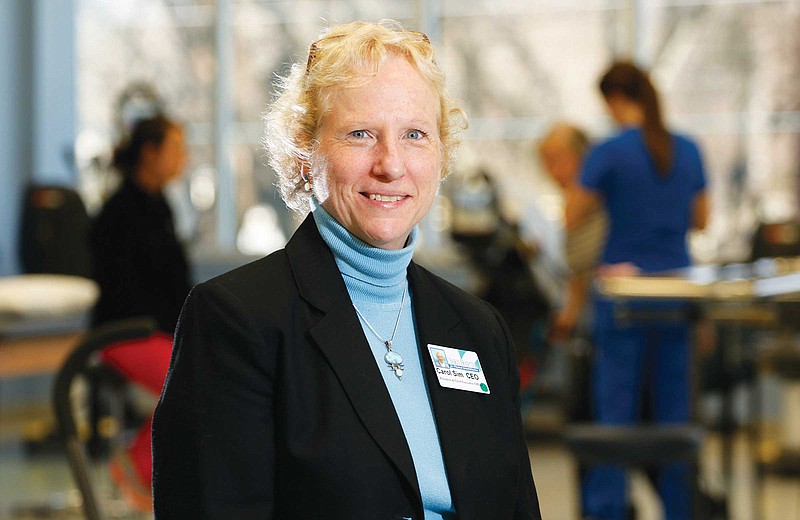Carol Sim, the CEO of Siskin Hospital for Physical Rehabilitation, is constantly scanning the horizon for health-care trends that intersect with the mission of her institution.
With a businesswoman's eye for improving efficiency and a nurse's heart for patients, the 59-year-old Cleveland, Ohio, native has just completed her second year at Siskin's helm. Long-time Siskin Hospital CEO Bob Main, who had guided the hospital since its opening, stepped down in 2013.
Sim, a registered nurse before she became a health-care administrator in the early 1990s, says her priorities for Siskin include it being in the vanguard of neurological rehabilitation and research, adapting to new outcomes-based insurance reimbursement models, and keeping Siskin's physical plant up to date with added parking spaces and state-of-the-art nursing equipment.
Sim says it was a "luxury" to follow Main in the job. "Bob Main had done an amazing job of articulating what Siskin's mission and values were," Sim says.
The fact that she is a woman made the hand-off easier, Sim says. "I wasn't trying to fill (Main's) shoes," she says. "Mine were a different pair of shoes."
Originally the 20th-century vision of Chattanooga industrialists and philanthropists, Mose and Garrison Siskin, Siskin Hospital on Centennial Drive near Erlanger Medical Center has grown into one of the leading facilities of its kind in the nation. When it opened in 1990, it was the first free-standing, not-for-profit rehabilitation hospitals in Tennessee.
With 109 inpatient beds and and a busy outpatient flow, Siskin recently added 108 sub-acute and nursing home beds with the acquisition of nearby St. Barnabas Healthcare Center, bringing total beds under the Siskin umbrella to 217. At the time of the acquisition in the summer of 2014, Siskin officials said the merger would allow patients a wider continuum of car. Siskin offers treatment for brain injuries, stroke, amputations, spinal chord injury, orthopedics and trauma.
Sim, who came to Chattanooga after a stint as CEO of HealthSouth Treasure Coast Rehabilitation Hospital, in Vero Beach, Florida, says there are advantages to guiding a non-for-profit hospital. These include being able to craft hybrid job descriptions for her staff, and to plan forward-looking care options without Wall Street oversight.
Sim grew up the child of a health care administrator who directed hospitals in Cleveland, Ohio, and New Haven, Connecticut. An Ivy Leaguer, Sim earned her degree in nursing from Columbia University in New York, and later returned to Columbia to obtain a masters degree in public health. She remained a nurse for over a decade and then became CEO of a visiting nurse association in Branford, Connecticut.
Over the next two decades, she worked her way up the career ladder, first at Spaulding Rehabilitation Hospital in Boston, then at Hospice and Palliative Care of Cape Cod and finally at Treasure Coast in Florida. Sim said she was attracted to the Siskin opening because of the hospital's reputation as a powerful lobbying voice for health-care policy and because of its not-for-profit status.
She said she wants to nourish and strengthen ties with Erlanger Medical Center's pioneering Center for Neurosciences and companion research going on at the University of Tennessee at Chattanooga. Research by these Chattanooga institutions promises to to improve patient outcomes by matching stroke victims to the most efficient treatment protocols, she said.
"The question we face every day is: How do you give somebody back their lives," Sim says.
New research indicates that stroke patients can show improvements months after it was thought possible, she said. Meanwhile, the future promises advances in rehab robot technology, stem cell therapy and implantable computer chips.
One of Sim's first orders of business was to invest in new nursing equipment at Siskin: vital signs machines, defibrillators, stretchers and IV pumps. As a nurse, she says she understands that without the best equipment on the front lines of care, patients can suffer. She also pushed to hire a nursing professor to help with continuing education for staff. Under development is a new electronic medical system for outpatients to ensure better continuity of care, she says.
One of her goals for the future is to continue to energize her staff to take ownership of the hospital's mission, she said. She said she constantly asks herself, "How do I get them jazzed about what they do every day." Sim says she has launched a series of town hall meetings involving staff at the hospital to answer three questions: "What is our heritage? Where are we now? Where are we headed?"
